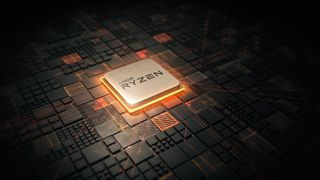TSMC lets us know how 5nm is shaping up – and it’s good news for AMD Ryzen 6000 CPUs
And others besides, with 3nm looking promising for a 2022 kick-off as well

TSMC has just divulged a host of info about its incoming (and existing) processes, with the chipmaker going into details regarding its 5nm and 3nm production – and more besides.
All this comes as part of the firm’s latest Technology Symposium, as spotted by Tom’s Hardware.
Starting with 5nm production, TSMC noted that its initial N5 process uses EUV tech ‘extensively’, and boasts up to 15% more performance (at the same power) compared to N7 (existing 7nm) – or maintaining the same performance, 5nm can offer a 30% power reduction (admittedly these are figures which have been shared before).
- Here are the best gaming PCs
- Check out the best processors
- Best PC games: the must-play titles you don’t want to miss
A further critical point here is that TSMC asserts that N5 is performing much better in terms of the defect density learning curve, meaning that better yields will be reached more swiftly than with 7nm – which is good news for all concerned.
5nm is in high volume manufacturing now, with initial customers being Apple and Huawei, and products should be imminent (like the expected 5nm-based A14X chip in the iPhone 12).
AMD is set to be moving to 5nm with Zen 4 chips, specifically with Ryzen 6000 processors in 2022 as we’ve seen in a recent leak, and indeed in another leak from a few months back, AMD was listed as a customer in 2021/2022 for 5nm with Zen 4 CPUs and RDNA 3 GPUs. Nvidia’s Hopper and Intel Xe GPUs were also listed in that same timeframe for 5nm (Intel is looking externally to third-party foundries in order to ease its own production woes).
Refined 5nm or 5NP (for high-performance applications) will ramp to production next year, and will offer 5% more performance compared to 5N, or a 10% power reduction.
Get daily insight, inspiration and deals in your inbox
Get the hottest deals available in your inbox plus news, reviews, opinion, analysis and more from the TechRadar team.
3nm and beyond
As for 3nm or N3, that particular step forward promises a 10% to 15% increase in performance compared to N5 – so a pretty similar to moving from N7 to N5 – or a 25% to 30% power reduction (again very similar). High volume manufacturing of 3nm is expected to kick off in the second half of 2022.
There will also be an N4 node, which as Tom’s notes will be IP-compatible with the N5 process, but no details have been shared about exactly what this will offer in terms of performance boosts or power efficiency yet. We do know that volume production is coming in 2022, though.
Looking further out to the future, there are some interesting technological innovations on the menu for TSMC, including nanosheets and nanowires, with new materials like carbon nanotubes (which we’ve heard a lot about previously, for some time now) being researched for making chips, as silicon is potentially left behind post-3nm.
- We'll show you how to build a PC
Darren is a freelancer writing news and features for TechRadar (and occasionally T3) across a broad range of computing topics including CPUs, GPUs, various other hardware, VPNs, antivirus and more. He has written about tech for the best part of three decades, and writes books in his spare time (his debut novel - 'I Know What You Did Last Supper' - was published by Hachette UK in 2013).
Most Popular


